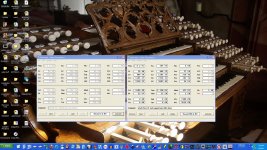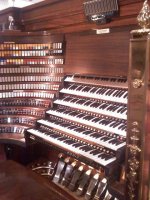Could this be written into a little DOS routine?Make a second copy of the 3 Hornresp files in a different folder. (Hornresp.exe, Hornresp.dat, msvbm60.dll) You can then start both copies.
You will need to use import/export to keep the two copies of hornresp.dat in sync. Or you can make any changes you want to save in one copy, then exit both and copy the hornresp.dat from one to the other. Be careful and keep backups, sooner or later you will mess it up...
One thing I often do for comparing graphs in Hornresp is to use Paint, the basic image editor included in Windows.
- Produce a graph in Hornresp.
- Capture it to clipboard (Alt-PrintScreen).
- Start Paint, paste (Ctrl-C).
- Produce another graph in Hornresp.
- Capture it to clipboard (Alt-PrintScreen).
- Turn off Draw Opaque in Paint (Image --> Draw Opaque, untick.)
- Paste (Ctrl-c)
How could that DOS program be called up by clicking on a windows icon " second Hornresp"
Can you download off of the AES site?
Yes, if you have e-library access you can download as much as you want. If you are not a member, you can purchase the articles one by one. If you need more than a few articles, it makes sense to pay for the e-lib access.
If some correlation between sound pressure and air particle velocity can be made, maybe we will have a useful tool in the design of horns and their physical dimensional aspect ratios. All these things add up to a better design if attention is paid to the correct details.
The correlation between particle velocity and pressure is impedance. Acoustic impedance is defined as pressure divided by (particle velocity times area). Note however that impedance is only defined as long as everything is linear.
Bjørn
I hope that first off I can get an anemometer that will behave.
Second a proper high spl mike that will behave.
Seems like using vehicle manifold MAP sensors would be ideal for these types of measurements.
GM
One thing I often do for comparing graphs in Hornresp is to use Paint, the basic image editor included in Windows.
I can highly recommend MWSnap3 for screen captures. Fast, free, easy to use and makes great captures in a small file size. I use it every day.


The correlation between particle velocity and pressure is impedance. Acoustic impedance is defined as pressure divided by (particle velocity times area). Note however that impedance is only defined as long as everything is linear.
Bjørn
Yep. What I meant is not only a theoretical understanding but the actual impedance versus change in horn aspect ratio or even horn total path surface area. Better stronger faster is what I'm after.
It seems that both things can make quite a difference in the outcome of a horns success.
GM
I think I have an even cheaper alternative.
Measurement specialties make some pretty inexpensive pressure transducers. They have to be able to measure very low pressures actually. And I am putting together an accelerometer to make insitu X-max measurements.
Measurement specialties make some pretty inexpensive pressure transducers. They have to be able to measure very low pressures actually. And I am putting together an accelerometer to make insitu X-max measurements.
Why don't you want to use microphones to measure pressure? If you use a pressure sensor, make sure it can measure the actual variation of pressure, and with a good enough BW and SNR, because it looks like many of the pressure sensors are made for measuring static pressure. (If you want to measure the distortion, SNR is quite important. The M52 mic needs > 120dB SPL to measure distortion realiably).
I have used an accelerometer from Measurement Specialities, the ACH-01 to measure diaphragm displacement, it works well. I found it was most stable to integrate (twice) from acceleration to displacement in SW, by first getting the acceleration frequency response, and then multiply twice by j*omega to get displacement.
Good luck.
Bjørn
I am going to use the G. Danavaras amplifier with the built in integrator. Easier than fooling around other ways. He's a smart guy no use me trying to improve on that design. Only wish I could find a PCB pattern.
Maybe I should get that crazy microphone.
Not cheap to be sure.
I have read some good things about the Linkwitz modification on the Panasonic cartridges. Just not sure if they will survive the high SPL at the throat.
Because you are correct Bjørn a pressure transducer will not read the transients. At least not the ones I will be able to afford.
Maybe I should get that crazy microphone.
Not cheap to be sure.
I have read some good things about the Linkwitz modification on the Panasonic cartridges. Just not sure if they will survive the high SPL at the throat.
Because you are correct Bjørn a pressure transducer will not read the transients. At least not the ones I will be able to afford.
Mr. McBean,
Thank you so much for the update and all of the new features.
I love the new mouseover crosshair cursor for sampling the values on the new graphs. Is there any chance this feature could be carried over to the existing graphs? It is much faster than keying in frequencies.
I've not found any issues or compatibility problems with the latest version. Thanks again for such a great piece of software.
Thank you so much for the update and all of the new features.
I love the new mouseover crosshair cursor for sampling the values on the new graphs. Is there any chance this feature could be carried over to the existing graphs? It is much faster than keying in frequencies.
I've not found any issues or compatibility problems with the latest version. Thanks again for such a great piece of software.
.....
I have read some good things about the Linkwitz modification on the Panasonic cartridges. Just not sure if they will survive the high SPL at the throat.
......
With the Linkwitz-modded mics, distortion becomes an issue above 130 dB. Not sure when the capsule fails, haven't built a sub that loud (yet...).
Near the throat it will be much in excess of 130 db.With the Linkwitz-modded mics, distortion becomes an issue above 130 dB. Not sure when the capsule fails, haven't built a sub that loud (yet...).
I have been doing some reading on changing the polarizing voltage. And I still have to find the cost on those piezo film type mics. Maybe a poor man can do some fancy measurements after all.
And what do you mean not built a sub that can do 130db!
Man!
NO Problemo
What I have to say is that using the new tools on some of my older designs I am intrigued by the results. The best performers are rather well balanced. In terms of pressure modulation and particle velocity. Things I always knew were important but had to more or less use "seat of the pants type engineering". The kind where you just know what will or will not perform. I guess that is born from doing this stuff for a long time. I had hair when I started working on horns. To much testing blew it all away. That's my story and I'm sticking to it!
Now I have a few tools that will get me much closer to knowing what will perform.
Now to quantify a few of these calculations and things will get a lot more interesting.
... I had hair when I started working on horns. To much testing blew it all away. That's my story and I'm sticking to it!
Thinking about horns generates heat. The heat kills the hair follicles. It's not all bad though, the heat then radiates away more efficiently and you can think even harder. That's *my* story and I'm sticking to it.
I love the new mouseover crosshair cursor for sampling the values on the new graphs. Is there any chance this feature could be carried over to the existing graphs?
Hi littlemike,
I will see what I can do - the cursor pointer will remain as the default shape, though.
It may take me a day or so...
Kind regards,
David
Hi littlemike,
I will see what I can do - the cursor pointer will remain as the default shape, though.
It may take me a day or so...
Kind regards,
David
Thank you very much!
- Home
- Loudspeakers
- Subwoofers
- Hornresp

